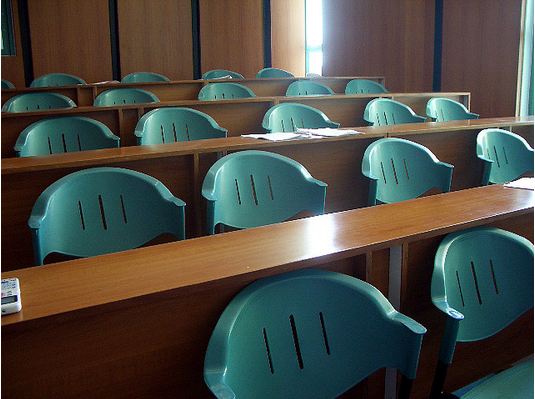
Read: America’s Best-Educated States
Read: America’s Worst-Educated States
Based on education data from the U.S. Census Bureau’s’ American Community Survey, 24/7 Wall St. identified the U.S. states with the largest and smallest percentages of residents 25 or older with a college degree or more.
The difference in median income between those with only a high school diploma and a college degree is dramatic. The median pay for U.S. adults with just a high school diploma was $26,699 in 2011. For those 25 or older with a bachelor’s degree, median annual earnings came to $48,309. Residents with a graduate or professional degree did even better; median annual earnings was $64,322.
Differences in poverty rates related to education are just as dramatic. For U.S. adults with at least bachelor’s degrees, the percentage living in poverty in 2011 was just 4.4%. For adults with only a high school diploma, 14.2% were living below the poverty line.
The effects of wage gap by education becomes clear when comparing the states by graduation rate. Of the 10 states with the largest percentage of college-educated residents, eight are in the top 10 for median income. Among the worst-educated states, eight are among the 10 with the lowest median income.
24/7 Wall St. reviewed the percentage of U.S. residents 25 or older with at least a bachelor’s degree for 2011 from the annual American Community Survey. From that survey, we obtained the percentage of adults that had completed an education at each major level, including high school, graduate and professional schools. We also examined poverty rates and median income for those at different levels of educational attainment.
These are America’s best and worst educated states.
America’s Best-Educated States
10. Minnesota
> Bachelor’s degree or higher: 32.4%
> Median household income: $56,954 (11th highest)
> Pct. below poverty level: 11.9% (11th lowest)
Nearly one in three Minnesota adults aged 25 or older has a bachelor’s degree or higher, the 10th-highest percentage in the country. Minnesota’s educational attainment at the earliest levels is even higher than it is at the college level. Just 4.7% of adults had started — but not completed — high school, compared to the 8.1% of adults who fell into that category nationally. Just 8% of Minnesotans 25 or older do not have a high school diploma, compared to the 14.1% nationwide. However, among states with the most college graduates, Minnesota has fewer adults who go on to the next level of education. Only 10.5% of adults have graduate or professional degrees, the 17th highest nationwide.
9. New York
> Bachelor’s degree or higher: 32.9%
> Median household income: $55,246 (16th highest)
> Pct. below poverty level: 16.0% (21st highest)
More than 14% of New Yorkers have an advanced degree, one of the highest percentages in the U.S. However, while many New Yorkers are highly educated, another large group lacks basic education. Just 85% of New Yorkers have at least a high school diploma, close to 1 percentage point below the national rate. Educational attainment dramatically affects New York residents’ ability to earn a living, where the median annual earnings for someone with only a high school diploma is $28,405, less than half the median earnings of $68,079 for someone with a graduate or professional degree.
Also Read: 10 Brands Losing the Most Value
8. New Hampshire
> Bachelor’s degree or higher: 33.4%
> Median household income: $62,647 (6th highest)
> Pct. below poverty level: 8.8% (the least)
More New Hampshire adults have at least completed high school than all but five states — 91.4%, compared to the national rate of 85.9%. The benefits for those 33.4% who have at least a bachelor’s degree are quite high. The state poverty rate is 8.8%, which is already the lowest in the country. Meanwhile, just 2.2% of those with at least a bachelor’s degree live below the poverty line, also the lowest rate in the country.
7. Virginia
> Bachelor’s degree or higher: 35.1%
> Median household income: $61,882 (7th highest)
> Pct. below poverty level: 11.5% (tied-8th lowest)
Although Virginia is one of the nation’s most-educated states, with 20.5% of adults with just bachelor’s degrees and another 14.6% with advanced degrees, the state still struggles to graduate many students from high school. According to the Census Bureau, only 87.8% of adult Virginians have high school diplomas — worse than any of the most-educated states, except New York. The median earnings for adults without high school diplomas is just $19,892 a year, compared to the median of $78,532 for residents with advanced degrees.
6. New Jersey
> Bachelor’s degree or higher: 35.3%
> Median household income: $67,458 (3rd highest)
> Pct. below poverty level: 10.4% (3rd lowest)
New Jersey is one of the most well-to-do states in the country, with just 10.4% of residents living below the poverty level, compared to a national rate of 15.9%. It also has the third-highest median household income in the country, at $67,458. Residents with bachelor’s degree also earn more than college graduates of any other state, at $60,107. The national median earnings for bachelor’s degree recipients is $48,309. More than 21% of New Jersey adults without a high school degree were living below the poverty line, compared to the just 3.1% of those with a bachelor’s degree or higher.
5. Vermont
> Bachelor’s degree or higher: 35.4%
> Median household income: $52,776 (19th highest)
> Pct. below poverty level: 11.5% (tied-8th lowest)
In Vermont, 35.4% of adult residents have at least a college degree, with 21.4% of the population holding a bachelor’s and another 14% holding a master’s, doctorate, or professional degree. Median earnings for adults with advanced degrees in Vermont is $50,593 a year — over $13,000 less than the national median. Only 2.8% of residents have less than a ninth grade education, less than half of the 6% nationwide, and another 5.5% finished ninth grade but dropped out of high school, one of the lowest rates in the nation. Among those aged 16 to 19, 97.2% were either in school or had graduated — the third-highest rate in the nation.
4. Connecticut
> Bachelor’s degree or higher: 36.2%
> Median household income: $65,753 (4th highest)
> Pct. below poverty level: 10.9% (5th lowest)
In Connecticut, an estimated 15.7% of the adult population has either a graduate or professional degree, one of the highest percentages in the U.S., behind only Massachusetts and Maryland. The median annual earnings for this group is $75,875, higher than all but a handful of states — twice the median earnings for an adult with only a high school diploma. Residents who don’t earn college also do well; median earnings for the group was $32,869, higher than in any other state.
Also Read: States That Drink the Most Beer
3. Colorado
> Bachelor’s degree or higher: 36.7%
> Median household income: $55,387 (15th highest)
> Pct. below poverty level: 13.5% (18th lowest)
Colorado residents are among the most-educated people in the country — 23.3% of the adults have completed up to a bachelor’s degrees and another 13.4% have also completed advanced degrees. Colorado’s high school participation and graduation rates below the national average. Only 94.1% of residents aged 16 to 19 are either in high school or have graduated.
2. Maryland
> Bachelor’s degree or higher: 36.9%
> Median household income: $70,004 (the highest)
> Pct. below poverty level: 10.1% (2nd lowest)
In Maryland, 16.5% of the population holds a graduate or professional degree of some kind, behind only Massachusetts. Residents with these degrees are among the highest paid in the country, with median annual earnings of $77,166, behind only New Jersey and Virginia. Only one state — New Hampshire — has a lower poverty rate than Maryland’s 10.1%. This rate is likely driven downwards by the 36.9% of adults who have college degrees, among whom the poverty rate is just 3.2%.
1. Massachusetts
> Bachelor’s degree or higher: 39.1%
> Median household income: $62,859 (5th highest)
> Pct. below poverty level: 11.6% (9th lowest)
In Massachusetts, 39.1% of adults have at least a bachelor’s degree, more than 10 percentage points above the national rate of 28.5%. Additionally, 16.8% of adults have a graduate or professional degree, again the highest percentage in the nation. Although the median annual earnings of $53,765 for those with a bachelor’s degree is very high, adults with either a graduate or a professional degree earn far more. Their median earnings exceed $70,000. Academic success is not limited to adults, as nearly 97% of individuals between the ages of 16 and 19 are either enrolled in high school or have graduated — one of the country’s highest rates.
Also Read: America’s Worst-Educated States
America’s Worst-Educated States
10. Oklahoma
> Bachelor’s degree or higher: 23.8%
> Median household income: $43,225 (10th lowest)
> Pct. below poverty level: 17.2% (16th highest)
Oklahoma is just one of 15 states in which less than a third of all adults have an associate’s degree or higher. Residents with graduate or professional degrees are also scarce in Oklahoma. Residents who do have an advanced degree in Oklahoma do not earn much — the median earnings for adults with graduate or professional degrees is just $51,631, the fifth-lowest in the nation. Of Oklahoma’s adults with less than a high school degree, 28.5% live below the poverty line, compared to the 4.3% with a bachelor’s degree or higher.
9. Tennessee
> Bachelor’s degree or higher: 23.6%
> Median household income: $41,693 (6th lowest)
> Pct. below poverty level: 18.3% (12th highest)
In Tennessee, the median earnings for an adult with an advanced degree is more than three times higher than that for a high school dropout. Despite the opportunity, just 8.3% of adults have graduate degrees, far below the national rate of 10.6%. Meanwhile 15.8% of adults lack even high school diplomas, well above the 14.1% for the U.S. overall. Residents with only a high school education are far more likely to live in poverty. Of residents with a high school education, 30.6% live in poverty, whereas only 3.8 of those who have at least bachelor’s degree live in poverty. One area in which Tennessee is especially strong: 96.4% of people aged 16 to 19 are either in high school or have their diploma, one of the higher rates in the U.S.
8. Indiana
> Bachelor’s degree or higher: 23.0%
> Median household income: $46,438 (20th lowest)
> Pct. below poverty level: 16.0% (21st highest)
By one measure, Indiana does well providing its residents with an education — the percentage of adults who graduated high school, at 87.3%, exceeds the national rate of 85.9%. For many, however, education ends after high school. Only 30.9% of adults have at least an associate’s degree, while only 23% have at least a bachelor’s degree, both among the lowest rates in the U.S. Additionally, just 94% of current residents between 16 and 19 are either in high school or have graduated, a low compared to the national rate of 95.1%.
Also Read: America’s Richest States
7. Nevada
> Bachelor’s degree or higher: 22.5%
> Median household income: $48,927 (24th lowest)
> Pct. below poverty level: 15.9% (23rd highest)
In Nevada, only 29.7% of adults have at least an associate’s degree, while the percentage of adults with a bachelor’s degree is just 22.5%. Both of these figures are among the nation’s worst. Within the state, 6% of adults with bachelor’s degrees still live below the poverty line, one of the worst rates in the country. Having a bachelor’s degree is not as much of an advantage in Nevada as it is in other parts of the country. Median earning for adults with less than a high school degree is well more than the national median. At the same time, those with at least a bachelor’s degree earn less than the median college graduate nationwide.
6. Alabama
> Bachelor’s degree or higher: 22.3%
> Median household income: $41,415 (5th lowest)
> Pct. below poverty level: 19.0% (7th highest)
Alabama has one of the nation’s worst high school attainment rates. Among adults 25 and older, 17.3% do not have high school diploma, the fifth-worst percentage in the U.S. For those aged 16 to 19, just 93.7% were either still in high school or had graduated, among the lowest rates in the nation. Only 22.3% of adults have at least a bachelor’s degree in Alabama. More than one in four Nevada adults have some college education, but have not completed a degree, compared to the 21.2% nationwide.
5. Louisiana
> Bachelor’s degree or higher: 21.1%
> Median household income: $41,734 (7th lowest)
> Pct. below poverty level: 20.4% (3rd highest)
Only 82.5% of adults in Louisiana have high school diplomas, one of the lowest percentages in the country. College education in the state is also low. Just 26.3% of adults have associate degrees or higher and only 21.1% have bachelor’s degrees or higher. Both these rates are well below national averages. Graduate and professional degrees are also low. Only 7.1% of adults have a graduate or professional degree, one of the lowest numbers in the country.
4. Kentucky
> Bachelor’s degree or higher: 21.1%
> Median household income: $41,141 (4th lowest)
> Pct. below poverty level: 19.1% (5th highest)
Kentucky residents are among the least likely to have a bachelor’s degree or high school diploma. Only 83.1% of adults have a high school education, and 7% of adults have not completed the ninth grade — both among the worst rates in the U.S. Residents without a high school education often struggle to earn a living — 32.1% live in poverty — more than twice the 15.5% poverty rate for adults who have finished high school. Despite the state’s many problems, Kentucky residents aged 16 to 19 are more likely to be either in school or to have graduated high school than their peers nationwide, at 95.7% versus 95.1% across the U.S.
Also Read: America’s Poorest States
3. Arkansas
> Bachelor’s degree or higher: 20.3%
> Median household income: $38,758 (3rd lowest)
> Pct. below poverty level: 19.5% (4th highest)
Not only is Arkansas among the 10 worst states in the nation for high school graduation rates, at 83.8%, but it also has the second-smallest proportion of adults with at least an associate’s degree, at just 26.1%. The poverty rate for adults with less than a high school education is seven times higher than for those with a bachelor’s degree or more.
2. Mississippi
> Bachelor’s degree or higher: 19.8%
> Median household income: $36,919 (the lowest)
> Pct. below poverty level: 22.6% (the highest)
Just 81.1% of adults in Mississippi are high school graduates, tied with Texas and California for the lowest percentage in the nation. Additionally, 6.6% of adults have not completed the ninth grade — especially troubling in a state with a poverty rate of 32.5% for those without a high school diploma. Although the median earnings for an adult with no education past high school is just $24,060 — one of the lowest figures in the nation — more than 80% of adults do not have a bachelor’s degree, while more than 70% have not completed an associate’s degree.
1. West Virginia
> Bachelor’s degree or higher: 18.5%
> Median household income: $38,482 (2nd lowest)
> Pct. below poverty level: 18.6% (10th highest)
Just 18.5% of West Virginians have at least a bachelor’s degree — 10 percentage points lower than the national rate of 28.5% and considerably lower than the next-lowest state, Mississippi. West Virginia is also the only state in the nation where less than 7% of adults have a graduate or professional degree. West Virginia adults are the least likely in the nation to have at least an associate’s degree, at 24.9%, compared to 36.3% nationwide. Median earnings for adults with an advanced degree in West Virginia is $52,308 — more than $12,000 below the national median.
Michael B. Sauter and Alexander E.M. Hess
Also Read: America’s Best-Educated States
Take Charge of Your Retirement In Just A Few Minutes (Sponsor)
Retirement planning doesn’t have to feel overwhelming. The key is finding expert guidance—and SmartAsset’s simple quiz makes it easier than ever for you to connect with a vetted financial advisor.
Here’s how it works:
- Answer a Few Simple Questions. Tell us a bit about your goals and preferences—it only takes a few minutes!
- Get Matched with Vetted Advisors Our smart tool matches you with up to three pre-screened, vetted advisors who serve your area and are held to a fiduciary standard to act in your best interests. Click here to begin
- Choose Your Fit Review their profiles, schedule an introductory call (or meet in person), and select the advisor who feel is right for you.
Why wait? Start building the retirement you’ve always dreamed of. Click here to get started today!
Thank you for reading! Have some feedback for us?
Contact the 24/7 Wall St. editorial team.





